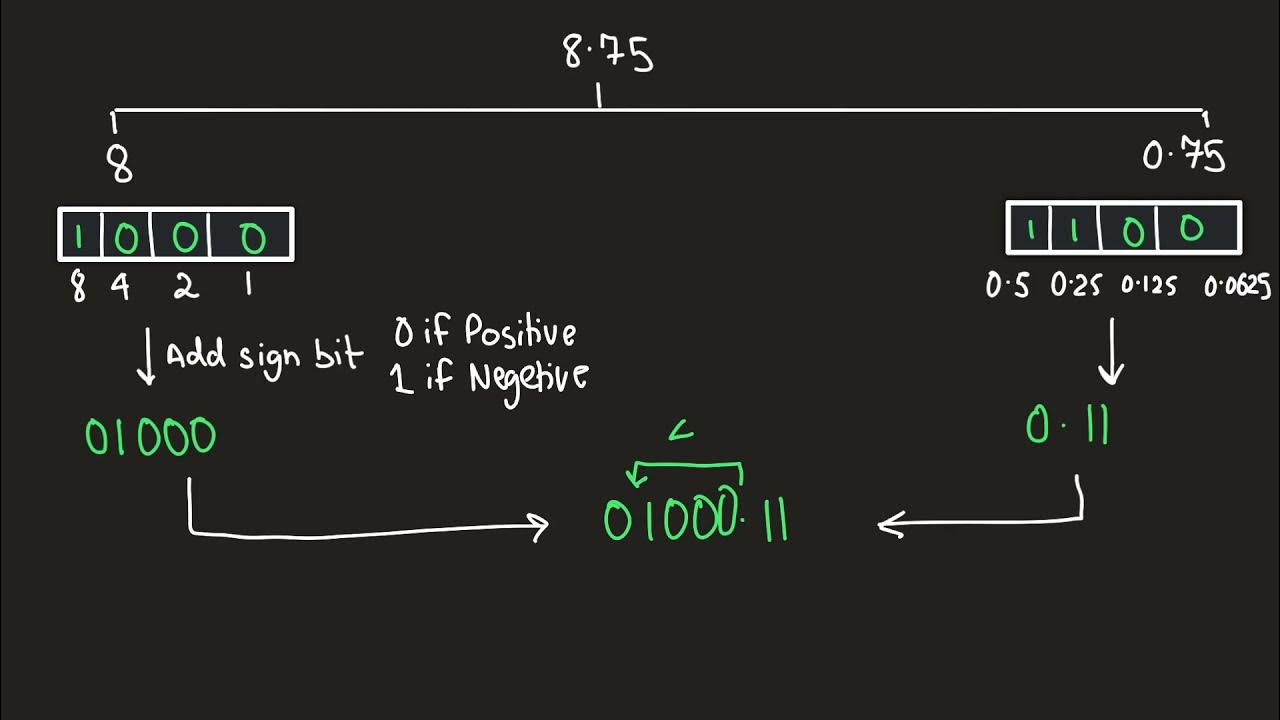8. CAMBRIDGE IGCSE (0478-0984) 1.1 Signed integers using two's complement
Summary
TLDRThis video explores signed integers using two's complement in binary representation. It explains how positive numbers are represented with a leading zero and negative numbers with a leading one. The concept of two's complement is introduced through an analogy of a car's odometer, showing how negative values can be represented by flipping the digits. The video demonstrates how to convert positive 117 into its negative counterpart using two's complement and offers a trick to easily find the negative version of any binary number by inverting the bits after the first one encountered when reading from right to left.
Takeaways
- 🔢 The smallest binary number representable in eight bits is zero, denoted by a sequence of zeros.
- 🚗 Adding ones in any column increases the binary value, similar to a car's odometer.
- 🔄 Negative numbers in binary are represented using two's complement, a method analogous to a car's odometer running backward.
- 🌐 Positive numbers in two's complement start with a zero, and negative numbers start with a one.
- 💡 The most significant bit (MSB) in two's complement represents negative values, flipping the traditional binary representation.
- 🔑 To represent a positive number in two's complement, place a zero in the MSB and fill other bits as needed to achieve the value.
- 🔄 To represent a negative number in two's complement, start with a one in the MSB and fill other bits to achieve the negative value.
- 🎯 The process of converting a positive binary number to its negative two's complement involves flipping bits after the first one encountered from the right.
- 🔄 Flipping bits after the first one from the right in a binary number is a reliable trick to get the negative two's complement.
- 📚 The correctness of two's complement representation can be verified by adding a number to its negative and expecting zero as the result.
Q & A
What is the smallest number that can be represented in binary using eight bits?
-The smallest number that can be represented in binary using eight bits is zero, which would be represented as a sequence of eight zeros.
How does adding ones to a binary number affect its value?
-Adding ones to a binary number increases its value. For example, adding a one to the least significant bit (rightmost column) increases the value from zero to one.
What is the concept used by computers to represent negative numbers in binary?
-Computers use a concept called two's complement to represent negative numbers in binary.
In two's complement, what is the significance of the most significant bit (MSB)?
-In two's complement, the most significant bit (MSB) represents a negative value, with a one indicating a negative number and a zero indicating a non-negative number.
How are positive numbers represented in two's complement?
-In two's complement, positive numbers start with a zero in the most significant bit, followed by the binary representation of the number.
What is the binary representation of the number 117 in two's complement?
-The binary representation of the positive number 117 in two's complement would have a zero in the most significant bit, followed by the binary digits that sum up to 117.
How can you represent the negative version of 117 using two's complement?
-To represent -117 in two's complement, you start with a one in the most significant bit and then place ones in the columns to bring the value up to -117, similar to how you would count up from -128.
What is the trick to convert a two's complement number into its negative version?
-To convert a two's complement number into its negative version, write out the positive version, then starting from the right, copy each digit up to and including the first one, and after that point, swap every one for a zero and every zero for a one.
How can you verify the correctness of the negative version of a number in two's complement?
-You can verify the correctness by adding the positive and negative versions of the number in two's complement, which should result in a row of zeros, indicating that the sum is zero.
What is the binary representation of negative 12 using the trick mentioned in the script?
-To represent -12 in binary using the trick, you start with the positive binary representation of 12 (1100), copy from the right up to and including the first one, and then invert the remaining bits, resulting in 1001, which is the two's complement representation of -12.
Outlines

此内容仅限付费用户访问。 请升级后访问。
立即升级Mindmap

此内容仅限付费用户访问。 请升级后访问。
立即升级Keywords

此内容仅限付费用户访问。 请升级后访问。
立即升级Highlights

此内容仅限付费用户访问。 请升级后访问。
立即升级Transcripts

此内容仅限付费用户访问。 请升级后访问。
立即升级浏览更多相关视频

Negative Number and Hexadecimal Representation

Belajar Python [Dasar] - 13 - Operator Bitwise

ECAP268 - U01L04 - Fixed point and floating point representation

Operators in Python | Bitwise Operators | Python Tutorials for Beginners #lec17

1's and 2's Complement

Data Representation - Mantissa And Exponents Part 3 - (A Level Computer Science Made Easy (A2) )
5.0 / 5 (0 votes)
